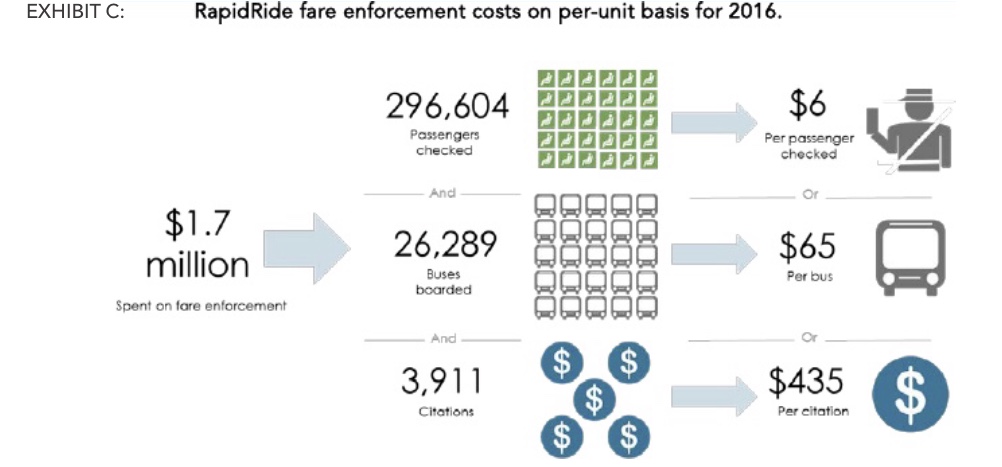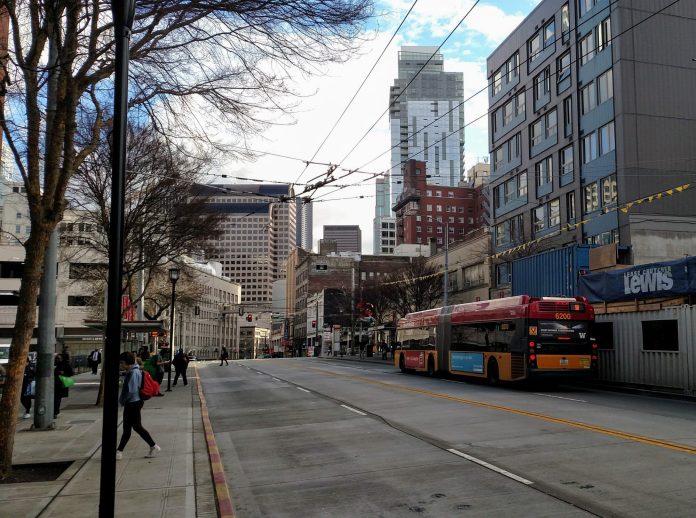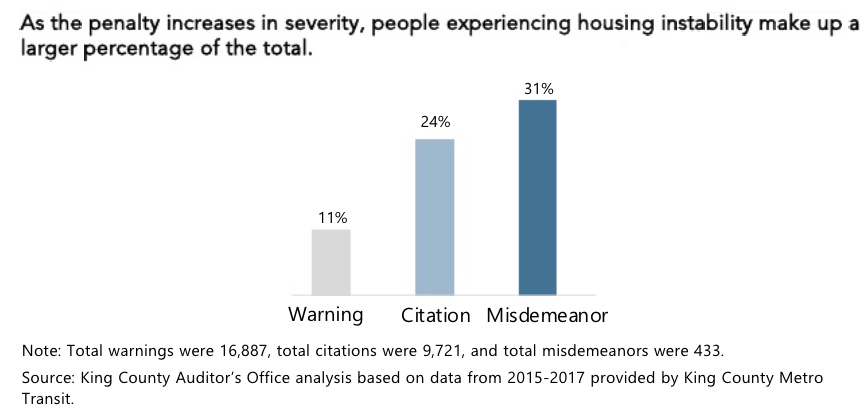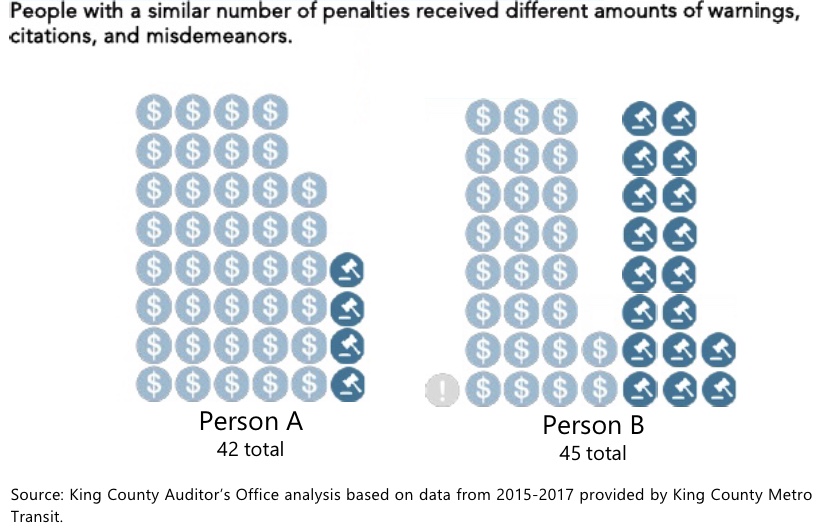On Wednesday, King County Metro Transit announced fare enforcement changes to promote more equitable outcomes for riders. The changes come on the heels of recommendations by the King County Auditor’s Office that laid out very concerning data suggesting people experiencing homelessness bear the brunt of citations and misdemeanor referrals. These people have the least ability to pay, highest need for mobility assistance, and most to lose by having charges on their record.
In January, I penned a piece “Are Transit Fare Violation Policies Fair?” that looked in to how Metro and Sound Transit are managing fare enforcement across their networks. At the time, Metro spokesperson Scott Gutierrez said that the agency wasn’t actively pursuing any changes, but does continually evaluate its policies.
Many Metro transit operators have long been concerned with how the agency enforces fare payment. A coalition of transit operators have been running a campaign called “Just Transit” with the goal of fully ending fare enforcement on RapidRide. The transit operators don’t want Metro to be in the business of “policing and criminalizing poor people and people of color.”
The fundamental purpose of fare enforcement is to discourage riders from evading fare payment and ensure higher cost recovery of transit service. Metro uses fare enforcement officers on RapidRide routes since the service allows for all-door boarding and off-board payment. It works on a proof-of-payment basis similar to Link light rail and Sounder commuter rail. Metro’s current fare enforcement protocol has three steps:
- First offense: verbal warning;
- Second offense: a $124 infraction; and
- Third offense: a misdemeanor citation referral to the King County Sheriff.
The audit provided several critically concerning findings on Metro’s fare enforcement practices:
- “Nearly 25 percent of all citations and 30 percent of misdemeanors are given to people who are homeless or experiencing housing instability, potentially creating debt and interactions with the criminal justice system. Those experiencing housing instability may have difficulty paying the fare or fine, which could create additional negative impacts beyond the citation. For example, the fines for individuals experiencing housing instability totaled just over $290,000 from 2015-2017. These fines, when unpaid, go into collections, which can then impact a person’s ability to obtain housing.”
- “Ninety-nine people received at least 10 penalties each between 2015 and 2017, totaling about six percent of all penalties during that time. Almost 19,000 people received penalties between 2015 and 2017. Of those people, 99 individuals (0.5 percent) received a total of 1,589 penalties or six percent of all penalties in this time period. One person received 53 penalties over two years.”
- “Impacts on equity are likely the result of multiple causes, including Transit’s lack of aligning fare enforcement with goals and a lack of specific monitoring for equity impacts. Transit has not aligned fare enforcement activities with its multiple goals and articulated to those implementing fare enforcement how to balance those goals. In absence of that guidance, the fare enforcement staff utilizes the tools available, which are giving out warnings, citations, and misdemeanors…Additionally, Transit’s fare enforcement model has not been examined for equity impacts. The model heavily focuses on the A and E lines, which Transit believes have the highest evasion rates. However, according to a Transit report, at least one of these lines, the E line, serves an area with a high minority population. This has left room for negative equity impacts to be inherent to the model since Transit focuses on the E line more than other lines, it means that people of color could make up a higher proportion of citations than if enforcement was more evenly distributed.”
In addition, the audit poured some very cold water on how Metro is carrying out its fare enforcement program and the efficacy of it:
- “Transit’s fare evasion rate appears relatively low, but the methodology for estimating fare evasion might not be accurate. Transit estimates the RapidRide fare evasion rate based on data collected by its fare enforcement officers. According to these estimates, between 2010 and 2016, the fare evasion rate on the RapidRide system ranged from 0.9 percent on the B line to three percent on the A and F lines. These rates are similar to rates on other systems that use off-board fare payment, including light rail…Recent research has shown that the methods used by Transit–dividing the number of evaders by the number of patrons checked–is not a reliable way to estimate fare evasion. One reason may be because when information is collected by uniformed officers, the would-be evaders disembark before being checked. Another reason is that the deployment of officers is not random.”
- “Although a link between evasion and fare enforcement is often assumed, the relationship is actually not clear. Bus and rail systems that allow off-board fare payment generally have some type of fare enforcement. However, research has not found a correlation between fare enforcement and fare evasion: systems that have a lot of fare enforcement report fare evasion rates that are similar to those that have more limited coverage.”
- “Transit has an operational target for deploying personnel, but lacks information necessary to assess the impacts of enforcement on evasion. Transit has set some operational targets, like the number of buses that should be boarded each day, but it does not have the performance information that could be used to show a link between fare enforcement and fare evasion, such as baselines and targets.”
- “ORCA card readers often do not work as intended, making it difficult for officers to determine whether a passenger has paid their fare. Passengers on King County Metro Transit used ORCA cards for more than 60 percent of boardings in the third quarter of 2017. Therefore, the ability to check whether a passenger has paid their fare via ORCA card is essential for fare enforcement officers.”
Five recommendations were issued by the King County Auditor’s Office:
- “Transit should establish a performance management system for fare enforcement, including establishing baselines, setting targets, and developing measures for outputs and outcomes.”
- “Transit should conduct a rigorous fare evasion study to understand the level of fare evasion on RapidRide at least every two years.”
- “Transit should review its fare enforcement model for alignment with county and agency goals and equity principles and use the results to update its model and the fare enforcement contract.”
- “Transit should work with the fare enforcement team to develop and implement a system for gathering data necessary to monitor for the equity impacts of fare enforcement.”
- “Transit should prioritize implementation of its stalled technology project to ensure that fare enforcement is conducted in the most efficient manner possible.”

Metro generally concurs with the five recommendations and plans to address each of them over the next two years. The transit agency has already instituted some reforms. These include suspending the practice of sending misdemeanor cases to the sheriff’s office, giving youth an extra verbal warning before doling out a citation, and providing more training and management of fare enforcement officers.
Over the summer, Metro will commission a stakeholder group to look into several topics and provide recommendations in the fall. The topics include developing options to encourage compliance with fare payment laws while not unduly penalizing low- and no-income individuals, collecting better data to evaluate the agency’s performance, identifying how procedures may create unintended consequences, and reviewing technology options that may provide alternative means for people to meet their fare payment obligations.
It’s not clear what all of this will ultimately look like, but Portland’s Trimet serves as a recent example of how a robust discussion on fare enforcement fairness resulted in more equitable protocols. In the fall, we’ll likely get a better sense of where Metro is headed. Will other local transit operators follow suit?
Stephen is a professional urban planner in Puget Sound with a passion for sustainable, livable, and diverse cities. He is especially interested in how policies, regulations, and programs can promote positive outcomes for communities. With stints in great cities like Bellingham and Cork, Stephen currently lives in Seattle. He primarily covers land use and transportation issues and has been with The Urbanist since 2014.




